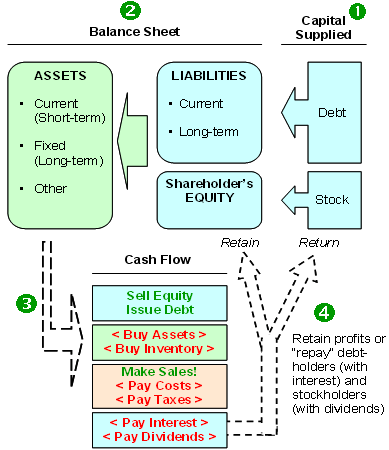Investopedia's Financial Statement Analysis
Financial Statements: The System
Tan KW
Publish date: Sun, 14 Jul 2013, 07:28 PM
By David Harper
(Contact David)
Financial statements paint a picture of the transactions that flow through a business. Each transaction or exchange - for example, the sale of a product or the use of a rented a building block - contributes to the whole picture.
Let's approach the financial statements by following a flow of cash-based transactions. In the illustration below, we have numbered four major steps:
 |
- Shareholders and lenders supply capital (cash) to the company.
-
The capital suppliers have claims on the company. The balance sheet is an updated record of the capital invested in the business. On the right-hand side of the balance sheet, lenders holdliabilities and shareholders hold equity. The equity claim is "residual", which means shareholders own whatever assets remain after deducting liabilities.
The capital is used to buy assets, which are itemized on the left-hand side of the balance sheet. The assets are current, such as inventory, or long-term, such as a manufacturing plant. - The assets are deployed to create cash flow in the current year (cash inflows are shown in green, outflows shown in red). Selling equity and issuing debt start the process by raising cash. The company then "puts the cash to use" by purchasing assets in order to create (build or buy) inventory. The inventory helps the company make sales (generate revenue), and most of the revenue is used to pay operating costs, which include salaries.
-
After paying costs (and taxes), the company can do three things with its cash profits. One, it can (or probably must) pay interest on its debt. Two, it can pay dividends to shareholders at its discretion. And three, it can retain or re-invest the remaining profits. The retained profits increase the shareholders' equity account (retained earnings). In theory, these reinvested funds are held for the shareholders' benefit and reflected in a higher share price.
This basic flow of cash through the business introduces two financial statements: the balance sheet and the statement of cash flows. It is often said that the balance sheet is a static financial snapshot taken at the end of the year (To read more, see What is a Cash Flow Statement? and Reading The Balance Sheet.)
Statement of Cash Flows
The statement of cash flows may be the most intuitive of all statements. We have already shown that, in basic terms, a company raises capital in order to buy assets that generate a profit. The statement of cash flows "follows the cash" according to these three core activities: (1) cash is raised from the capital suppliers - cash flow from financing, (CFF), (2) cash is used to buy assets - cash flow from investing (CFI), and (3) cash is used to create a profit - cash flow from operations (CFO).
However, for better or worse, the technical classifications of some cash flows are not intuitive. Below we recast the "natural" order of cash flows into their technical classifications:
 |
You can see the statement of cash flows breaks into three sections:
- Cash flow from financing (CFF) includes cash received (inflow) for the issuance of debt and equity. As expected, CFF is reduced by dividends paid (outflow).
- Cash flow from investing (CFI) is usually negative because the biggest portion is the expenditure (outflow) for the purchase of long-term assets such as plants or machinery. But it can include cash received from separate (that is, not consolidated) investments or joint ventures. Finally, it can include the one-time cash inflows/outflows due to acquisitions anddivestitures.
- Cash flow from operations (CFO) naturally includes cash collected for sales and cash spent to generate sales. This includes operating expenses such as salaries, rent and taxes. But notice two additional items that reduce CFO: cash paid for inventory and interest paid on debt.
The total of the three sections of the cash flow statement equals net cash flow: CFF + CFI + CFO = net cash flow. We might be tempted to use net cash flow as a performance measure, but the main problem is that it includes financing flows. Specifically, it could be abnormally high simply because the company issued debt to raise cash, or abnormally low because it spent cash in order to retire debt.
CFO by itself is a good but imperfect performance measure. Consider just one of the problems with CFO caused by the unnatural re-classification illustrated above. Notice that interest paid on debt (interest expense) is separated from dividends paid: interest paid reduces CFO but dividends paid reduce CFF. Both repay suppliers of capital, but the cash flow statement separates them. As such, because dividends are not reflected in CFO, a company can boost CFO simply by issuing new stock in order to retire old debt. If all other things are equal, this equity-for-debt swap would boost CFO.
In the next installment of this series, we will discuss the adjustments you can make to the statement of cash flows to achieve a more "normal" measure of cash flow.
http://www.investopedia.com/university/financialstatements/financialstatements2.asp
More articles on Investopedia's Financial Statement Analysis
Discussions
Be the first to like this. Showing 0 of 0 comments














